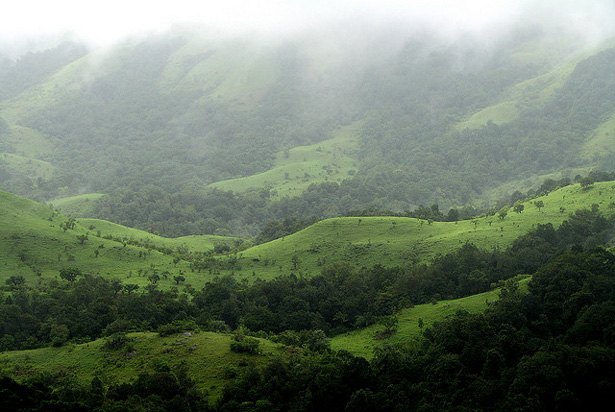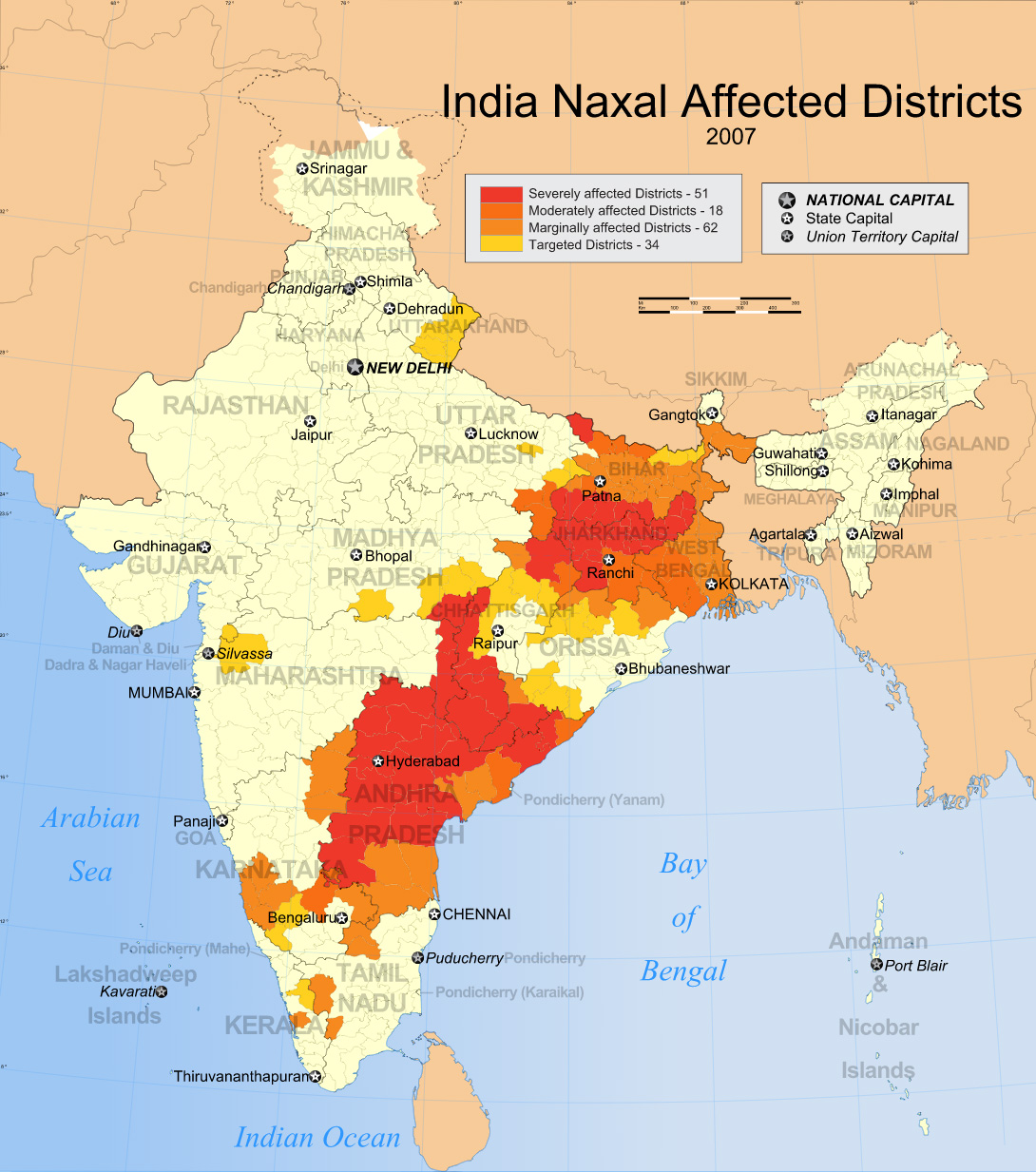-
What’s Worth Saving? Maoists, Forests, and Development in India’s Western Ghats
June 18, 2013 By Dhanasree Jayaram
Arrayed along India’s southwest coast is a 1,600-kilometer-long mountain chain with forests older than the Himalayas: the Western Ghats. The mountains are one of the top biodiversity hotspots in the world, and UNESCO recently recognized the region as a World Heritage site. They’re also one of the tensest of India’s emerging battlegrounds between development and conservation and a potential recruiting ground for its Maoist insurgency, called the country’s “greatest threat to internal security.”
India’s Amazon at Risk
The Western Ghats are home to more than 1,500 endemic species of flowering plants; at least 500 endemic species of fishes, amphibians, reptiles, birds, and mammals; 300 globally threatened species; and many more undiscovered species. They hold one of India’s four watersheds and several national parks, wildlife sanctuaries, and reserve forests. Any threat to the health of the Western Ghats will affect the ecological, environmental, socio-economic, and political well-being of the country.
For decades since independence, the Western Ghats have been at the center of several controversies due to a host of developmental projects inside the range or on its fringes. Power projects have, for instance, diverted “large chunks of forest lands either for power plant structures and/or transmission lines,” leading to the “fragmentation of forests, restricted animal movements, accelerated deterioration of forest, and introduction of alien species,” according to the Ministry of the Environment and Forests.
Mining, especially illegal mining, has been another menace. In many pockets, mining activity has led to severe degradation of forests or near-complete loss. Other consequences of mining include biodiversity loss; sedimentation of river beds and estuaries; threats to soil fertility and agriculture due to waste water discharge; threats to hydrology due to over-pumping of ground water; and air pollution triggered by the movement of minerals by road and rail.
Development vs. Conservation
The development vs. conservation argument is epitomized by the dueling recommendations of two government-funded groups of environmental experts and other professionals from both governmental and non-governmental institutions: the Western Ghats Ecology Expert Panel, headed by ecologist Madhav Gadgil, and a High Level Working Group, headed by space scientist Krishnaswamy Kasturirangan.
The Western Ghats Ecology Expert Panel has called for declaring the entire Ghats an “ecologically sensitive area,” much to the chagrin of pro-development lobbies. The panel produced a report, submitted in August 2011, which divides the Western Ghats into three categories: Ecologically Sensitive Zones (ESZ) I, II, and III. It recommended that the Ministry of Environment and Forests take steps to phase out mining in ESZ I by 2016, to continue existing mining in ESZ II but put an effective system of social auditing in place, and to allow new developmental projects in ESZ III. It also recommended that the ministry not give environmental clearance to two specific hydropower projects – the Gundia hydroelectric power project in Karnataka (home to lion-tailed macaques, cuckoo bees, travancore flying squirrels, and niligiri martens) and the Ahtirapilly dam on the Chalakudy river in Trichur district of Kerala (home to hornbills, torrent frogs, lion-tailed macaques, and cane turtles). The report was rejected by state governments and industry as implementation of its recommendations would curb development in nearly 70 percent of the region.
In response to the Gadgil panel’s recommendations, the government appointed the High Level Working Group to examine the report and find a compromise formula. The Kasturirangan panel mellowed the recommendations to a great extent by, they said, taking into account human habitation and peoples’ livelihoods in the region – giving equal weight to both human and nature. After using satellite data and remote sensing technology to distinguish between “natural landscapes” (undeveloped areas that constitute about 42 percent of the region, by their reckoning) and “cultural landscapes” (human settlements, agricultural fields, and plantations covering 58 percent of the region), the Kasturirangan panel identified only 37 percent of the Western Ghats as ecologically sensitive. Moreover, the panel called for incentivizing green and sustainable practices in the region, rather than banning development outright. The result would reduce the area of the Western Ghats identified as ecologically sensitive by nearly half. Still, certain state governments remain dissatisfied.
A Maoist Threat?
What many analysts in India have not looked at is the close linkages between environmental and human security in the Western Ghats in terms of the growing menace of the Maoist, or “Naxalite,” insurgency.
Unknown to many Westerners, India’s Maoist insurgency is a serious internal revolt against the state that is at least partially rooted in grievances related to natural resource management and government development policy.
 The expansion of the “Red Corridor” – the mostly forested region in the east of the country where the insurgency has been most active – has been in the news especially of late, in the wake of the brutal killing of at least 18 people in the state of Chhattisgarh, including former Union Minister V. C. Shukla and senior Congress leader Mahendra Karma. Although certainly not entirely to blame, environmental management issues do play a role in driving displaced communities, particularly tribal communities, into the Maoist movement in the Western Ghats. Maoists have been active in the area since at least 2002 and Gadgil’s report certainly has given them more ammunition for new slogans against the so-called imperialists. According to the Home Ministry, there is some evidence that Maoists are in the process of forming a “Western Ghats Special Zonal Committee,” that would include Karnataka, Kerala, and Tamil Nadu.
The expansion of the “Red Corridor” – the mostly forested region in the east of the country where the insurgency has been most active – has been in the news especially of late, in the wake of the brutal killing of at least 18 people in the state of Chhattisgarh, including former Union Minister V. C. Shukla and senior Congress leader Mahendra Karma. Although certainly not entirely to blame, environmental management issues do play a role in driving displaced communities, particularly tribal communities, into the Maoist movement in the Western Ghats. Maoists have been active in the area since at least 2002 and Gadgil’s report certainly has given them more ammunition for new slogans against the so-called imperialists. According to the Home Ministry, there is some evidence that Maoists are in the process of forming a “Western Ghats Special Zonal Committee,” that would include Karnataka, Kerala, and Tamil Nadu.It is difficult to dismiss the tribal communities’ grievances. In the case of Kudremukh National Park, the national government uprooted the tribal population forcefully from their traditional habitat and took away their livelihoods to protect the forests. It is in situations like Kudremukh that the government needs to take effective measures to prevent conflict by either peacefully resettling the tribes or declaring them as a biodiversity asset so they will not be deprived of their rights to use the forests in traditional ways under the Forest Rights Act of 2006 (e.g., collecting “minor forest produce” – non-timber forest products, such as medicinal and aromatic plants, oil seeds, fiber and floss, bamboo, reeds, grasses, and so on).
At the same time, the state governments in the region claim that granting the World Heritage tag to the whole area or implementing Gadgil’s recommendations would actually fuel Maoism, as it would prevent the establishment from carrying out development activities. The lack of development and loss of livelihoods, they argue, would then lead to even more “anti-social activities.”
It is an open question whether or not the heritage tag would restrict development. It certainly would not uproot people or destroy their livelihoods, consequences of the current policy which are likely to create recruits for the Maoists as well. However, this debate reflects the complexity of the issue.
The Need of the Hour
The first and foremost step to solving this conundrum would be to implement a community-based approach to the management of the Western Ghats’ forests and their resources instead of the current top-down approach. Local communities that have the best understanding of the region should be part of the decision-making process. When communities are a part of the process, there is also much less risk that they will become disillusioned and feed the Maoist insurgency against the state.
To check illegal activities, like strip mining, logging, wildlife trade, and encroachment that are so destructive to the Western Ghats ecology and its people, law enforcement agencies need to pull up their socks. Although the mountains stretch across several different states, the central government needs to lead by example by strengthening its existing environmental impact assessment mechanism so that not every industry project is given environmental clearance.
Further, whichever set of recommendations – Gadgil’s, Kasturirangan’s, or some combination – is settled on, ecological biodiversity needs to be recognized as an integral part of the human landscape as well as the environmental. A demarcation between the two shifts the focus away from the basic fact that the environment is our infrastructure and that development without ecological considerations is not sustainable.
Saving the entire Western Ghats should be a priority for the government, not saving the remaining Western Ghats.
Dhanasree Jayaram is a Ph.D. candidate in the Department of Geopolitics and International Relations at Manipal University, Karnataka, and an associate fellow at the Centre for Air Power Studies in New Delhi. Her book Breaking out of the Green House: Indian Leadership in Times of Environmental Change was published in 2012.
Sources: Critical Ecosystem Partnership Fund, Deccan Chronicle, Deccan Herald, Down To Earth, The Hindu, The Hindu Centre, Hindustan Times, The Indian Express, Mangalorean, Ministry of the Environment and Forests (India), Naxal Revolution, Press Trust of India, Sanctuary Asia, The Times of India, Union Ministry of Environment and Forest’s High Level Working Group, Western Ghats Ecology Expert Panel, Zee News.
Photo Credit: The Kudremukh range, courtesy of flickr user Karunakar Rayker; India’s Red Corridor, courtesy of Planemad/Wikimedia Commons.
 A Publication of the Stimson Center.
A Publication of the Stimson Center.




